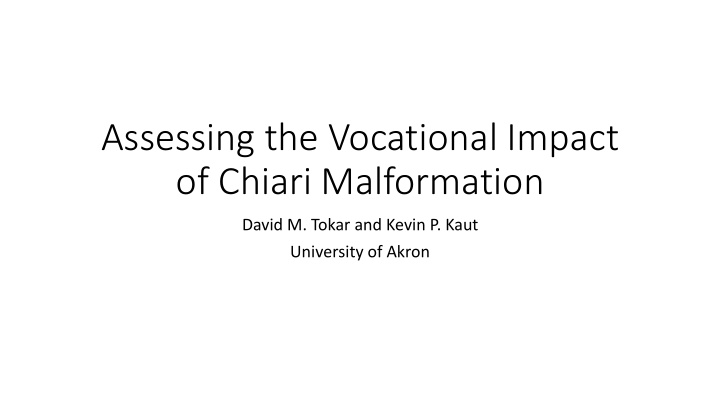



Assessing the Vocational Impact of Chiari Malformation David M. Tokar and Kevin P. Kaut University of Akron
Background and Overview • Clinical manifestations of Chiari malformation (CM) are fairly well- documented (Fischbein et al., 2015; Mueller & Oro, 2004) • However, little is known about the effects of CM on work outcomes and other aspects of people’s work lives • Two primary purposes of our research: • (1) provide descriptive data on the impact of CM on work-related experiences (e.g., job satisfaction and performance, coworker relationships) • (2) test the applicability of the Psychology of Working Theory (PWT; Duffy, Blustein, Diemer, & Autin, 2016) for individuals with CM
Purpose 1: Descriptive Data • We developed an online survey containing: • Established measures of key career development constructs (e.g., person- environment fit, job satisfaction) • Perceived work-related consequences of CM • Data collected 2 ways: • 648 adults from the Chiari 1000 registry • Link to the survey on Conquer Chiari website • Final usable sample included 323 working adults with CM
Purpose 1: Descriptive Data • Data indicate that CM has a number of significant adverse effects on the work lives of those with the condition. • Two of those adverse effects — economic constraints and marginalization — figure prominently in the recently published Psychology of Working Theory (PWT; Duffy et al., 2016). • Thus, the PWT is an ideal framework for studying the work experiences of those with CM.
Purpose 2: Testing the Applicability of the PWT • The central construct of the PWT (Duffy et al., 2016) is “decent work,” defined as work that affords: • safe working conditions • access to health care • adequate compensation • free time and rest • workplace values compatible with family and social values • According to the PWT, economic constraints (i.e., limited resources) and marginalization (e.g., ableist workplace discrimination) are contextual barriers to securing decent work (see Figure 1).
Purpose 2: Testing the Applicability of the PWT • Economic constraints and marginalization are posited to limit people’s ability to secure decent work both directly and indirectly. • Indirect effects are via their effects on: • work volition (perceived career decision-making ability despite constraints) • career adaptability (coping resources for career-related challenges).
Purpose 2: Testing the Applicability of the PWT • Data collection included measures of PWT constructs. • e.g., a measure of perceived discrimination faced by individuals with any chronic health condition (in this case, CM) • Results of structural equation modeling analyses indicated that the hypothesized model fit the data well; thus the PWT appears to be a useful framework for predicting decent work among individuals with CM. • Figure 2 (next slide) summarizes the standardized parameter estimates for hypothesized PWT paths.
Purpose 2: Testing the Applicability of the PWT • Notable findings: • having fewer economic resources and experiencing more ableist discrimination were perceived as substantial barriers to securing decent work • having fewer economic resources and experiencing more ableist discrimination also were associated with a diminished sense of control in career decision making (i.e., less work volition) • having fewer economic resources was associated with a reduced capacity to adjust to career-related challenges (i.e., less career adaptability)
Future Directions • We plan to explore some of the PWT’s posited outcomes of decent work — including work fulfillment (e.g., job satisfaction) and overall well-being — among workers with CM.
Recommend
More recommend